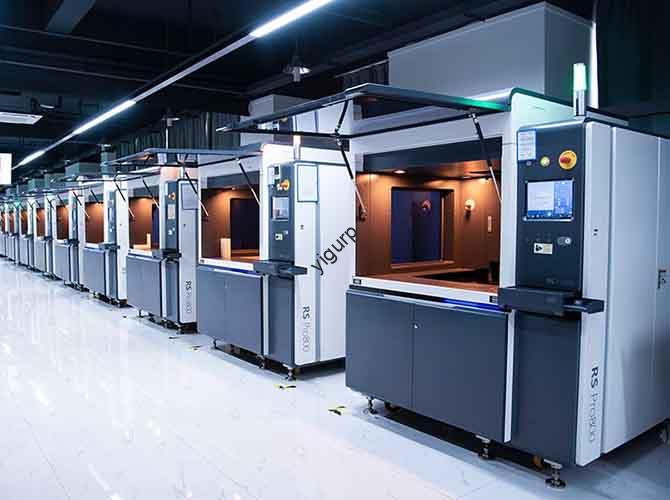Are you tired of plain, impressions 3D monochromes qui ne parviennent pas à capturer des détails fins ou des couleurs réalistes? 3D impression de cartes de couleurs résoudre ce problème en fusionnant avancé 3Technologie d'impression D avec une reproduction précise des couleurs, transformant les conceptions numériques en couleurs éclatantes, objets tridimensionnels. Ce guide détaille tout ce que vous devez savoir pour exploiter efficacement cette technologie.
1. Que sont les cartes de couleurs d'impression 3D? Une ventilation technique
À la base, 3D impression de cartes de couleurs are processes that add color to 3D prints during production, pas après. Unlike traditional 2D printing (which lays ink on flat surfaces), 3D color printing embeds color into every layer of the object—ensuring long-lasting vibrancy even on wearable or high-use parts.
Deux méthodes de coloration clés
| Méthode | Comment ça marche | Avantage clé |
| Ink/Dye Infusion | Ink or dye is applied directly to the printed material as each layer forms. | Ideal for smooth, surfaces détaillées (Par exemple, figurines or medical models). |
| CMYK Material Mixing | Colored filaments (Cyan, Magenta, Yellow, Key/Black) are blended in precise ratios. | Achieves thousands of color combinations, including exact Pantone matches. |
Pensez-y comme cuire un gâteau: 2D printing is adding frosting on top, alors que 3D impression de cartes de couleurs are mixing food coloring into the batter—color runs through the entire product, not just the surface.
2. Pourquoi choisir des cartes de couleurs d'impression 3D? 5 Des avantages imbattables
For designers, fabricants, et les éducateurs, 3D impression de cartes de couleurs eliminate common pain points of traditional 3D printing. Voici comment:
- No Extra Cost for Color: Generate colorful models directly from digital files—no need to budget for post-print painting or coloring.
- Gagner du temps: Skip manual coloring (which can take hours or days for complex parts) and get ready-to-use prototypes in hours.
- Durable Color: Color stays intact on high-wear areas (Par exemple, toy parts or tool handles) because it’s embedded in the material.
- Precision Matching: Achieve accurate skin tones, brand colors (like Coca-Cola red), or Pantone shades—critical for medical or marketing projects.
- Liberté de conception: Create complex, multicolored details (Par exemple, a 3D map with different colors for oceans, forests, and cities) that 2D prints can’t replicate.
3. Applications du monde réel: Où brillent les cartes couleur de l’impression 3D
3D impression de cartes de couleurs aren’t just for art—they’re transforming industries by solving unique problems. Below are three key use cases:
Cas 1: Industrie médicale
Doctors often struggle to explain complex injuries (like a fractured skull) to patients with plain models. Avec 3D impression de cartes de couleurs, they can create models where:
- Broken bones are highlighted in red.
- Healthy tissue is shown in pink.
- Surgical plans are marked in blue.
This makes diagnosis and treatment discussions 50% more intuitive, selon un 2023 study by the Journal of Medical Imaging.
Cas 2: Éducation
Teaching geology? A 3D-printed color map of the Earth’s crust can show:
- Mantle (orange)
- Outer core (rouge)
- Inner core (jaune)
Students retain 3x more information when using these tactile, colored models compared to 2D textbooks (National Education Association, 2024).
Cas 3: Art & Conception
Artists can now replicate famous sculptures (Par exemple, Michelangelo’s David) avec:
- Realistic skin tones
- Colored clothing details
- Even weathered textures
Museums use these prints to let visitors touch art without damaging the original.
4. Tendances futures: Quelle est la prochaine étape pour l’impression 3D de cartes couleur?
The technology is evolving fast—here’s what to expect in the next 3–5 years:
| S'orienter | Impact | Chronologie |
| Réduire les coûts | Entry-level 3D color printers will drop from \(5,000 à \)1,500, making them accessible to small businesses. | 2025–2026 |
| Nouveaux matériaux | Heat-resistant and flexible colored filaments will enable use in aerospace (Par exemple, colored engine parts) and fashion (Par exemple, 3D-printed shoes). | 2026–2027 |
| AI Integration | AI will auto-adjust color ratios for perfect matches, reducing human error by 70%. | 2024–2025 |
Imaginez ça: Par 2027, a small jewelry designer could 3D-print a custom necklace with the exact color of a customer’s favorite flower—all in under an hour, for less than $50. That’s the power of advancing 3D impression de cartes de couleurs.
5. Perspective de la technologie Yigu
À la technologie Yigu, nous croyons 3D impression de cartes de couleurs are the future of personalized manufacturing. Our team has tested this technology with clients in medical and education—seeing firsthand how it cuts production time by 40% and improves user engagement. We’re investing in AI-driven color calibration tools to make 3D color printing even more accessible. Pour les entreprises, now is the time to adopt this tech: it’s no longer a “nice-to-have” but a “must-have” to stay competitive.
FAQ
- Q: Can 3D printing color maps match any Pantone color?
UN: Oui! Using CMYK material mixing, most 3D color printers can match over 90% of Pantone shades—perfect for brand-specific projects.
- Q: Are 3D-printed color objects durable?
UN: Absolument. Since color is embedded in the material (not just the surface), these objects resist fading, scratching, and wear—even with regular use.
- Q: Do I need special software to create 3D printing color maps?
UN: Most standard 3D design tools (Par exemple, Mixer, Fusion 360) now support color mapping. You can also use dedicated tools like PrusaSlicer for easier color adjustments.
